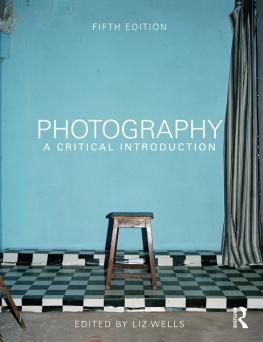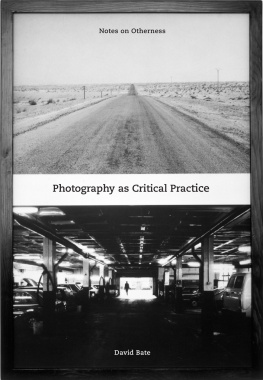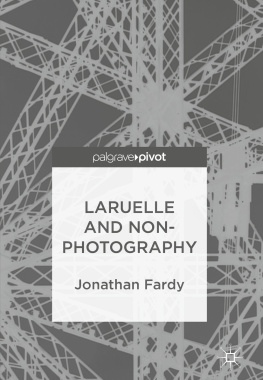A knowledge of photography is just as important as that of the alphabet. The illiterate of the future will be ignorant of the use of camera and pen alike.
Thinking about photography
Debates, historically and now
In his Preface to Photography, A Very Short Introduction , historian Steve Edwards asks us to imagine a world without photography (Edwards 2006). His point, of course, is that it is almost impossible for us to do so; photography permeates all aspects of our life, acting as a principal source and repository of information about our world of experience. It follows that historical, theoretical and philosophical explorations of photographs as images and objects, and of photography as a range of types of practice operating in varying contexts, are necessarily wide-ranging. There is no single history of photography.
As E.H. Carr has observed, history is a construct consequent upon the questions asked by the historian (Carr 1964). Thus, he suggests, histories tell us as much about the historian as about the period or subject under interrogation. Stories told reflect what the historian hopes to find, and where information is sought. He was writing in an era when libraries and archives were the primary research locations. Nowadays we may start by researching online. But his note of caution remains relevant: fact gathering may be influenced by many factors, not least the particular networks used by web-based search engines. It is up to us to evaluate the status of our sources and the significance of our findings.
Further more, the historians selection and organisation of material is to some extent predetermined by the purpose and intellectual parameters of any particular project. Such parameters reflect particular institutional constraints as well as the interests of the historian (for instance, academics may be expected to complete research within a set period of time). Projects are also framed by underpinning ideological and political assumptions and priorities.
Such observations are obviously pertinent when considering the history of photography. They are also relevant to investigating ways in which photography has been implicated in the construction of history. As the French cultural critic, Roland Barthes, has pointed out, the nineteenth century gave us both history and photography. He distinguishes between history which he describes as memory fabricated according to positive formulas, and the photograph defined as but fugitive testimony (Barthes 1984: 93).
Attitudes to photography, its contexts, usages, and critiques of its nature are explored here through brief discussion of key writings on photography. The chapter is in four sections: Aesthetics and technologies, Contemporary debates, Histories of photography, and Photography and social history. The principal aim is to locate writings about photography both in terms of its own history, as a specific medium and set of practices, and in relation to broader historical, theoretical and political considerations. Thus we introduce and consider some of the different approaches and difficulties which emerge in relation to the project of theorising photography. The references are to relatively recent publications, and to current debates about photography; however, these books often refer back to earlier writings, so a history of changing ideas can be discerned. This history focuses on photography itself as well as considering photography alongside art history and theory, and cultural history and theory more generally.
As with any abbreviated history, this chapter can only offer brief summaries of some of the historical turning points and theoretical concerns that have informed and characterised debates about photography from its inception. Our aim is to identify some key questions and offer starting points for further research and discussion which are taken up in the following chapters and also through the references to further reading (in margins and notes). Photography is ubiquitous and it penetrates culture in very diverse ways. Nowadays, it plays a central role within social media on the one hand, while being a major factor within the art market on the other. These activities go on alongside longer standing fields of operation (including but not restricted to: documentary and photojournalism; people and places; personal, domestic and family photog raphy; travel, exploration and representation of cultures other than our own; commerce and advertising). The questions that we might ask, then, shift according to the type of practice being considered, but whatever the field of operation analysis of the role of photographic images is always pertinent to critical interrogations.
In the 1920s, when Moholy-Nagy commented on the future importance of camera literacy, he could hardly have anticipated the extent to which photographic imagery would come to permeate contemporary communication. Indeed, the late twentieth-century convergence of audio-visual technologies with computing led to a profound and ongoing transformation in the ways in which we record, interpret and interact with the world.
In recent years this has been marked both by the astonishing speed of innovation and by a rapid extension and incorporation of technologies within new social, cultural, political and economic domains. As Martin Lister remarked in 2009, we have witnessed a number of convergences: between photography and computer-generated imaging (CGI), between photographic archives and electronic databases, and between the camera, the internet and personal mobile media, notably the mobile telephone (Lister in Wells 2009). Indeed, nowadays the mobile (cell) phone is also the camera.
We often see this ferment of activity as a defining feature of the twenty-first century and, perhaps, think of it as a unique moment in human history. But, in the 1850s, many people also thought of themselves as living in the forefront of a technological revolution. From this historical distance, it is hard to recapture the extraordinary excitement that was generated in the middle of the nineteenth century by a cluster of emerging technologies. These included inventions in the electrical industries and discoveries in optics and in chemistry, which led to the development of the new means of communication that was to become so important to so many spheres of life photography. Hailed as a great techno logical invention, photography immediately became the subject of debates concerning its aesthetic status and social uses.
The excitement generated by the announcement, or marketing, of innovations tends to distract us from the fact that technologies are researched and developed in human societies. New machinery is normally presented as the agent of social change, not as the outcome of a desire for such change, i.e. as a cause rather than a consequence of culture. However, it can be argued that particular cultures invest in and develop new machines and technologies in order to satisfy previously foreseen social needs. Photography is one such example. A number of theorists have identified precursors of photography in the late eighteenth century. For instance, an expanding middle-class demand for portraiture which outstripped available (painted) means led to the development of the mechanical physiognotracespontaneously fix themselves from as early as 1782 (Batchen 1990: 9). Since most of the necessary elements of technological knowledge were in place well before 1839, the significant question is not so much who invented photography but rather why it became an active field of research and discovery at that particular point in time (Punt 1995).
Once a technology exists, it may become adapted and introduced into social use in a variety of both foreseen and unforeseen ways. As cultural theorist Raymond Williams has argued, there is nothing in a technology itself which determines its cultural location or usage (Williams 1974). If technology is viewed as determining cultural uses, much remains to be explained. Not the least of this is the extent to which people subvert technologies or invent new uses which had never originally been intended or envisaged. In addition, new technologies become incorporated within established relations of production and consumption, contributing to articulating but not causing shifts and changes in such relations and patterns of behaviour.




